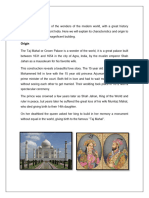Taj Mahal - Wonder of The World
Taj Mahal - Wonder of The World
Uploaded by
Rizwan ChouhanCopyright:
Available Formats
Taj Mahal - Wonder of The World
Taj Mahal - Wonder of The World
Uploaded by
Rizwan ChouhanOriginal Title
Copyright
Available Formats
Share this document
Did you find this document useful?
Is this content inappropriate?
Copyright:
Available Formats
Taj Mahal - Wonder of The World
Taj Mahal - Wonder of The World
Uploaded by
Rizwan ChouhanCopyright:
Available Formats
TAJ MAHAL
Taj Mahal - Wonder of the World:
To people the world over, the Taj Mahal, mausoleum of Mughal Emperor shah
Jana's chief wife, Mumtaz Mahal, is synonymous with India. Its curving,
gently swelling dome and the square base upon which its rests so lightly is a
familiar image from hundreds of brochures and travel books. The Taj is
undoubtedly one of the most spectacular buildings of the world. Renowned
for its architectural magnificence and aesthetic beauty, it counts among
man's proudest creations and is invariably included in the list of the world's
foremost wonders. As a tomb, it has no match upon earth, for mortal
remains have never been housed in greater grandeur.
The Origin of Tajmahal:
The origin of the name the "Taj Mahal" is not clear. Court histories from Shah
Jehan's reign only call it the rauza (tomb) of Mumtaz Mahal. It is generally
believed that "Taj Mahal" (usually translated as either "Crown Palace" or
"Crown of the Palace") is an abbreviated version of her name, Mumtaz Mahal
(Exalted One of the Palace).
The Taj Mahal is a deserving resting palace for an Emperor's Empress. It
stands on the banks of the river Yamuna, which otherwise serves as a wide
moat defending the Great Red Fort of Agra, the center of the Mughal
emperors until they moved their capital to Delhi in 1637. It was built by the
fifth Mughal emperor, Shah Jahan in 1631 in memory of his second wife,
Mumtaz Mahal, a Muslim Persian princess. She died while accompanying her
husband in Burhanpur in a campaign to crush a rebellion after giving birth to
their 14th child.
Beginning of a Love Story:
The story goes back in 1607, when a prince of the royal Mughal household
strolled down the Meena Bazaar, accompanied by a string of fawning
courtiers, he caught a glimpse of a girl hawking silk and glass beads. Five
years and a wife later (in those days princes did not marry for love alone) the
regal 20-yr-old went to wed his 19-yr-old bride. It was a fairy tale union from
the start, one that withstood court intrigues, battles for succession and
finally, the grand coronation. And when she died on the 19th year of their
marriage, he etched her story in stone. The Taj Mahal is the living symbol of
the monumental passion of Shah Jahan and Arjumand Banu. Which other
love story has so grand a memorial?
Mumtaj Mahal - "Build me a Taj"
As Mumtaz Mahal lay dying, she asked four promises from the emperor: first,
that he build the Taj; second, that he should marry again; third, that he be
kind to their children; and fourth, that he visit the tomb on her death
anniversary. He kept the first and second promises. Construction began in
1631 and was completed in 22 years. Twenty thousand people were deployed
to work on it. The principal architect was the Iranian architect Istad Usa; it is
possible that the pietra dura work was coordinated by an Italian artist.
Architecture of the TajMahal:
Construction began in 1631, and over 20,000 workmen and master
craftsmen worked laboriously for 22 years to give shape to the emperor's
passionate dream! The material was brought in from all over India and
central Asia and it took a fleet of 1,000 elephants to transport it to the site.
The complex was finally completed in 1653 at a cost of 32 Million Rupees
(approx USD 68000) on the banks of river Yamuna in Agra, the capital of the
Mughal monarchs.
But the beauty of Taj Mahal is also tainted by the gory fact that the hands of
some of the master craftsmen were amputated, to ensure that the perfection
of the Taj could never be repeated ever again!
History of Taj MahaL:
A green carpet of garden, a Persian garden, runs from the main gateway to
the foot of the Taj Mahal. Such gardens were introduced to India by Babur,
the first Mughal emperor, who also brought with him the Persian infatuation
with flowers and fruit, birds and leaves, symmetry and delicacy.
Unlike other Oriental gardens - especially those of the Japanese, who learned
to accentuate existing resources rather than formalise them - the Persian
garden was artificially contrived, unbashedly man-made, based on geometric
arrangements of nature without any attempt at a "natural" look.
The mausoleum, instead of occupying the central point (like most mughal
mausoleums), stands majestically at the north end just above the river. Each
of the four quarters of the garden has been sub-divided into 16 flower beds
by stone-paved raised pathways. At the centre of the garden, halfway
between the tomb and the gateway, stands a raised marble lotus-tank with a
cusped border. The tank has been arranged to perfectly reflect the Taj in its
waters.
A clear, unobstructed view of the mausoleum is available from any spot in
the garden. Fountains and solemn rows of cypress trees only adorn the
north-south water canal, lest the attention of the viewer would be diverted to
the sides !! This shows how carefully the aesthetic effect of the water devices
and the garden were calculated. The deep green cypress trees with their
slender rising shapes and curving topmost crests are mirrored in the water
while between their dark reflections shines the beauty of the immortal Taj
Mahal.
What leading travel books say about the Taj Mahal:
1:The Taj Mahal is a dream in marble.
India
Insight Guides
2:The greatest love story ever told in stone is epitomized in the Taj Mahal.
India
Spectrum Guides
You might also like
- Taj MahalDocument7 pagesTaj Mahalnirmalkumar4638661No ratings yet
- Taj Mahal - The True StoryDocument2 pagesTaj Mahal - The True StoryAnimesh VermaNo ratings yet
- Taj Mahal - Symbol of LoveDocument7 pagesTaj Mahal - Symbol of LoveArun K GuptaNo ratings yet
- History of Taj MahalDocument5 pagesHistory of Taj MahalManthira ChimizhNo ratings yet
- in/myindia/images/mumtaz1.jpg /in/myindia/images/mumtaz1.jpg /in/myindia/images/agra01.jpg /in/myindia/images/agra01.jpgDocument5 pagesin/myindia/images/mumtaz1.jpg /in/myindia/images/mumtaz1.jpg /in/myindia/images/agra01.jpg /in/myindia/images/agra01.jpgatifunaldiNo ratings yet
- Tɑ DƷ MƏ Hɑ L/ Hindi Urdu Mausoleum Agra India Mughal Emperor Shah Jahan Mumtaz Mahal Mughal Architecture Persian Islamic Indian Unesco World Heritage Site Domed MarbleDocument5 pagesTɑ DƷ MƏ Hɑ L/ Hindi Urdu Mausoleum Agra India Mughal Emperor Shah Jahan Mumtaz Mahal Mughal Architecture Persian Islamic Indian Unesco World Heritage Site Domed Marblekaskarvishnu1986No ratings yet
- All About Taj Mahal: A Kid's Guide to India’s Most Famous Monument: Educational Books For Kids, #4From EverandAll About Taj Mahal: A Kid's Guide to India’s Most Famous Monument: Educational Books For Kids, #4No ratings yet
- Taj Mahal IndiaDocument2 pagesTaj Mahal IndiaSinmbf LostNo ratings yet
- Taj Mahal - enDocument1 pageTaj Mahal - enПетя ДановаNo ratings yet
- Taj MahalDocument2 pagesTaj MahalALISSON GEOVANNA LEMA CHAVEZNo ratings yet
- Bangladesh University of Business and Technology (BUBT) : Name Id Intake SectionDocument21 pagesBangladesh University of Business and Technology (BUBT) : Name Id Intake SectionShadman SakibNo ratings yet
- The Taj Mahal - WPS OfficeDocument6 pagesThe Taj Mahal - WPS OfficemarkjosephvistaNo ratings yet
- TAJMAHALDocument4 pagesTAJMAHALSamuel Galindo Montaño.No ratings yet
- Taj Mahal WoiDocument2 pagesTaj Mahal WoiKhairul AmirulNo ratings yet
- Taj MahalDocument2 pagesTaj MahalR RNo ratings yet
- Taj MahalDocument11 pagesTaj MahalCAMELIA MANESCUNo ratings yet
- PML1Document2 pagesPML1jafasoh293No ratings yet
- Taj MahalDocument1 pageTaj MahalllucianassisNo ratings yet
- Taj MahalDocument2 pagesTaj MahalJyotiraditya Kumar JhaNo ratings yet
- Proyecto Taj MahalDocument2 pagesProyecto Taj Mahaldannacr108No ratings yet
- My Favourite Trip To : A Presentation by SrimithaDocument13 pagesMy Favourite Trip To : A Presentation by SrimithaAnand ChinnappanNo ratings yet
- Which Lends Charm To Its BeautyDocument3 pagesWhich Lends Charm To Its BeautySanjana BhandiwadNo ratings yet
- Taj MahalDocument3 pagesTaj MahalJega SkyNo ratings yet
- World Wonders Taj MahalDocument4 pagesWorld Wonders Taj Mahalmaria arockiamNo ratings yet
- Study On The Architecture of Taj Mahal: Narjes Falakian, Ali FalakianDocument7 pagesStudy On The Architecture of Taj Mahal: Narjes Falakian, Ali Falakianjanhavi28No ratings yet
- Taj MahalDocument2 pagesTaj Mahalmhi24No ratings yet
- The Most Photographed Monument - : Taj MahalDocument3 pagesThe Most Photographed Monument - : Taj MahalprasanjeetbNo ratings yet
- Taj Mahal ReportDocument2 pagesTaj Mahal Reportaqsam aliNo ratings yet
- Project On Taj MahalDocument5 pagesProject On Taj MahalInvisible ShadowNo ratings yet
- Seven Wonders of WorldDocument1 pageSeven Wonders of WorldTutor Seri KembanganNo ratings yet
- The Taj Mahal Stands As A Timeless Testament To Love and Architectural BrillianceDocument1 pageThe Taj Mahal Stands As A Timeless Testament To Love and Architectural Brillianceasdgaming554No ratings yet
- The Tajmahal: by Zahid Hasan BBA, Royal University of DhakaDocument1 pageThe Tajmahal: by Zahid Hasan BBA, Royal University of DhakaZahid HasanNo ratings yet
- Taj MahalDocument65 pagesTaj MahalAngel HomesNo ratings yet
- Taj MahalDocument2 pagesTaj MahalRaechelle Jhay ZafraNo ratings yet
- UNESCO World Heritage Sites in India Taj MahalDocument68 pagesUNESCO World Heritage Sites in India Taj MahalVlad AdomnicaiNo ratings yet
- TajmahalDocument12 pagesTajmahalĐỗ Thị Thúy 3D-20ACNNo ratings yet
- Taj MahalDocument3 pagesTaj Mahaltravel_memoriesNo ratings yet
- Taj MahalDocument9 pagesTaj Mahalsnigdhabanerjee1985No ratings yet
- Taj MahalDocument2 pagesTaj MahalMoni LisaNo ratings yet
- The Taj Mahal 71 Fascinating Facts For Kids Facts About The Taj MahalDocument33 pagesThe Taj Mahal 71 Fascinating Facts For Kids Facts About The Taj MahalSWARNABH .No ratings yet
- Report On Agra ND JaipurDocument12 pagesReport On Agra ND JaipurHarish NegiNo ratings yet
- Taj Mahal Is Regarded As One of The Eight Wonders of The WorldDocument5 pagesTaj Mahal Is Regarded As One of The Eight Wonders of The WorldelainemagcalasNo ratings yet
- Taj Mahal Was Chosen For Its Beautiful ArchitectureDocument2 pagesTaj Mahal Was Chosen For Its Beautiful ArchitectureSolo En NorcoreaNo ratings yet
- Research ProjectDocument8 pagesResearch Projectapi-312174841No ratings yet
- India ResearchDocument86 pagesIndia Researchms_paupauNo ratings yet
- Taj MahalDocument2 pagesTaj MahalkarisajachNo ratings yet
- Taj Mahal ImportanceDocument4 pagesTaj Mahal ImportancesaishNo ratings yet
- Shah Jahan PresentationDocument30 pagesShah Jahan PresentationjyothibellaryvNo ratings yet
- History of The Taj MahalDocument6 pagesHistory of The Taj MahalYusleimin MartinezNo ratings yet
- General Studies Project: Taj Mahal: The True StoryDocument21 pagesGeneral Studies Project: Taj Mahal: The True StoryAyaan PunjabiNo ratings yet
- Taj Mahal EditedDocument23 pagesTaj Mahal EditedSrikethan VarangantiNo ratings yet
- The 7 Wonders of The Modern WorldDocument2 pagesThe 7 Wonders of The Modern WorldMaria Angelica Moreno O.No ratings yet
- StructureDocument2 pagesStructuredannacr108No ratings yet
- Taj MahalDocument1 pageTaj MahalAnnabethNo ratings yet
- Strategy DeckDocument5 pagesStrategy DeckAlexsandra VovcNo ratings yet
- The Timeless Majesty of The Taj MahalDocument1 pageThe Timeless Majesty of The Taj MahalMarjun JacosalemNo ratings yet
- Project Management-Taj MahalDocument20 pagesProject Management-Taj MahalAbdul Ghani67% (3)
- AotR 2.9 Patch NotesDocument8 pagesAotR 2.9 Patch NotesEvan hendersonNo ratings yet
- HMS Iron Duke (F234)Document5 pagesHMS Iron Duke (F234)rbnaoNo ratings yet
- Motul Classic Oil SAE 50Document1 pageMotul Classic Oil SAE 50Susheel HindupurNo ratings yet
- Activity 3Document5 pagesActivity 3Yvan Edzel GeneralNo ratings yet
- 11 Homeostasis Biology Notes IGCSE 2014Document13 pages11 Homeostasis Biology Notes IGCSE 2014sabah8800100% (2)
- Auto Repair - BMW Convertible-Old E46 Maintenance ScheduleDocument2 pagesAuto Repair - BMW Convertible-Old E46 Maintenance SchedulemarkoloniusNo ratings yet
- Hoods Own 1000113437 PDFDocument583 pagesHoods Own 1000113437 PDFjurebieNo ratings yet
- 2727 Ijet IjensDocument5 pages2727 Ijet IjensPrashanth Kannar KNo ratings yet
- Egyptian Pottery in Middle Bronze Age AshkelonDocument9 pagesEgyptian Pottery in Middle Bronze Age Ashkelonsychev_dmitryNo ratings yet
- Arroz Con Gandules - Rice With Pigeon Peas - Puerto Rican RecipeDocument2 pagesArroz Con Gandules - Rice With Pigeon Peas - Puerto Rican RecipeAJNo ratings yet
- KFC Swot AnalysisDocument10 pagesKFC Swot AnalysisAvishek Sengupta100% (3)
- Carboguard - 1340 MSDS-BDocument9 pagesCarboguard - 1340 MSDS-BAyman JadNo ratings yet
- Composeal Universal: Benchtop Tube SealerDocument2 pagesComposeal Universal: Benchtop Tube SealerRafael VitorNo ratings yet
- Series ECS: Vishay SferniceDocument3 pagesSeries ECS: Vishay Sfernicemarius borcauNo ratings yet
- Ch35 Manual enDocument2 pagesCh35 Manual enStewart ChimkomolaNo ratings yet
- Hameed Khlaif 2019 IOP Conf. Ser. Mater. Sci. Eng. 579 012012 PDFDocument8 pagesHameed Khlaif 2019 IOP Conf. Ser. Mater. Sci. Eng. 579 012012 PDFHassan FaheemNo ratings yet
- Chem1701 Lab Week11Document6 pagesChem1701 Lab Week11api-711740031No ratings yet
- Pfs Course 4Document11 pagesPfs Course 4juan perez arrikitaunNo ratings yet
- WD403Document3 pagesWD403alikuncoro1005No ratings yet
- NPTI PGDC - Final Prospectus - Summer-2022-23 - CompressedDocument28 pagesNPTI PGDC - Final Prospectus - Summer-2022-23 - CompressedAbhishek SinghNo ratings yet
- Tinctura Rubea (Red Tincture) - Sometimes, As The Heavenly Body, It Is The Possessor of Magically EffectiveDocument1 pageTinctura Rubea (Red Tincture) - Sometimes, As The Heavenly Body, It Is The Possessor of Magically Effectiveshams ƎddineNo ratings yet
- Honeywell 620 0090 Manual 2014121694046Document42 pagesHoneywell 620 0090 Manual 2014121694046pvzxtrqrymruvdblvsNo ratings yet
- s10040 011 0767 5Document2 pagess10040 011 0767 5dimaNo ratings yet
- Nazilatul Meet 2,3 and 4Document5 pagesNazilatul Meet 2,3 and 4nazilatulazhomi17No ratings yet
- Lab Screening For Bleeding DisordersDocument40 pagesLab Screening For Bleeding Disordersmichael firmanNo ratings yet
- BP Case StudyDocument4 pagesBP Case StudyStephen J FischerNo ratings yet
- ESD AssignmentDocument3 pagesESD Assignmentsantosh vighneshwar hegdeNo ratings yet
- CA02 ParchamentoJVMDocument6 pagesCA02 ParchamentoJVMJohnrey ParchamentoNo ratings yet
- Volcanoes Lesson (Without Worksheets)Document7 pagesVolcanoes Lesson (Without Worksheets)api-287109691No ratings yet
- Service Manual: DHT-S514Document48 pagesService Manual: DHT-S514Mateusz MisiakNo ratings yet

























































































